The paralogous genes RADICAL-INDUCED CELL DEATH1 and SIMILAR TO RCD ONE1 have partially redundant functions during Arabidopsis development
- PMID: 19625634
- PMCID: PMC2736012
- DOI: 10.1104/pp.109.142786
The paralogous genes RADICAL-INDUCED CELL DEATH1 and SIMILAR TO RCD ONE1 have partially redundant functions during Arabidopsis development
Erratum in
- Plant Physiol. 2009 Oct;151(2):966
Abstract
RADICAL-INDUCED CELL DEATH1 (RCD1) and SIMILAR TO RCD ONE1 (SRO1) are the only two proteins encoded in the Arabidopsis (Arabidopsis thaliana) genome containing both a putative poly(ADP-ribose) polymerase catalytic domain and a WWE protein-protein interaction domain, although similar proteins have been found in other eukaryotes. Poly(ADP-ribose) polymerases mediate the attachment of ADP-ribose units from donor NAD(+) molecules to target proteins and have been implicated in a number of processes, including DNA repair, apoptosis, transcription, and chromatin remodeling. We have isolated mutants in both RCD1 and SRO1, rcd1-3 and sro1-1, respectively. rcd1-3 plants display phenotypic defects as reported for previously isolated alleles, most notably reduced stature. In addition, rcd1-3 mutants display a number of additional developmental defects in root architecture and maintenance of reproductive development. While single mutant sro1-1 plants are relatively normal, loss of a single dose of SRO1 in the rcd1-3 background increases the severity of several developmental defects, implying that these genes do share some functions. However, rcd1-3 and sro1-1 mutants behave differently in several developmental events and abiotic stress responses, suggesting that they also have distinct functions. Remarkably, rcd1-3; sro1-1 double mutants display severe defects in embryogenesis and postembryonic development. This study shows that RCD1 and SRO1 are at least partially redundant and that they are essential genes for plant development.
Figures
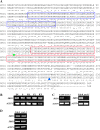
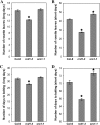

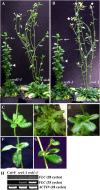
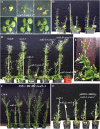
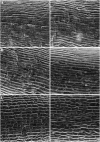
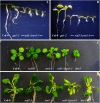

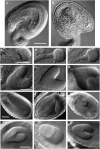

Comment in
-
Radical-induced cell death1 and similar to RCD one1 and the stress-induced morphogenetic response.Plant Signal Behav. 2010 Feb;5(2):143-5. doi: 10.4161/psb.5.2.10400. Epub 2010 Feb 21. Plant Signal Behav. 2010. PMID: 20009514 Free PMC article.
Similar articles
-
Unequally redundant RCD1 and SRO1 mediate stress and developmental responses and interact with transcription factors.Plant J. 2009 Oct;60(2):268-79. doi: 10.1111/j.1365-313X.2009.03951.x. Epub 2009 Jun 22. Plant J. 2009. PMID: 19548978
-
RCD1 and SRO1 are necessary to maintain meristematic fate in Arabidopsis thaliana.J Exp Bot. 2011 Jan;62(3):1271-84. doi: 10.1093/jxb/erq363. Epub 2010 Dec 13. J Exp Bot. 2011. PMID: 21172813 Free PMC article.
-
The transcription factor interacting protein RCD1 contains a novel conserved domain.Plant Signal Behav. 2010 Jan;5(1):78-80. doi: 10.4161/psb.5.1.10293. Plant Signal Behav. 2010. PMID: 20592818 Free PMC article.
-
Plant PARPs, PARGs and PARP-like Proteins.Curr Protein Pept Sci. 2016;17(7):713-723. doi: 10.2174/1389203717666160419144721. Curr Protein Pept Sci. 2016. PMID: 27090905 Review.
-
Arabidopsis thaliana uncoupling proteins (AtUCPs): insights into gene expression during development and stress response and epigenetic regulation.J Bioenerg Biomembr. 2011 Feb;43(1):71-9. doi: 10.1007/s10863-011-9336-9. J Bioenerg Biomembr. 2011. PMID: 21301941 Review.
Cited by
-
Genome-Wide Identification and Analysis of SRO Gene Family in Chinese Cabbage (Brassica rapa L.).Plants (Basel). 2020 Sep 18;9(9):1235. doi: 10.3390/plants9091235. Plants (Basel). 2020. PMID: 32962109 Free PMC article.
-
Linking genome wide RNA sequencing with physio-biochemical and cytological responses to catalogue key genes and metabolic pathways for alkalinity stress tolerance in lentil (Lens culinaris Medikus).BMC Plant Biol. 2022 Mar 5;22(1):99. doi: 10.1186/s12870-022-03489-w. BMC Plant Biol. 2022. PMID: 35247970 Free PMC article.
-
The radical induced cell death protein 1 (RCD1) supports transcriptional activation of genes for chloroplast antioxidant enzymes.Front Plant Sci. 2014 Sep 23;5:475. doi: 10.3389/fpls.2014.00475. eCollection 2014. Front Plant Sci. 2014. PMID: 25295044 Free PMC article.
-
Genome-wide identification of SIMILAR to RCD ONE (SRO) gene family in rapeseed (Brassica napus L.) reveals their role in drought stress response.Plant Signal Behav. 2024 Dec 31;19(1):2379128. doi: 10.1080/15592324.2024.2379128. Epub 2024 Jul 14. Plant Signal Behav. 2024. PMID: 39003725 Free PMC article.
-
Chemical PARP inhibition enhances growth of Arabidopsis and reduces anthocyanin accumulation and the activation of stress protective mechanisms.PLoS One. 2012;7(5):e37287. doi: 10.1371/journal.pone.0037287. Epub 2012 May 25. PLoS One. 2012. PMID: 22662141 Free PMC article.
References
-
- Adams-Phillips L, Wan J, Tan X, Dunning FM, Meyers BC, Michelmore RW, Bent AF (2008) Discovery of ADP-ribosylation and other plant defense pathway elements through expression profiling of four different Arabidopsis-Pseudomonas R-avr interactions. Mol Plant Microbe Interact 21 646–657 - PubMed
-
- Aguiar RC, Takeyama K, He C, Kreinbrink K, Shipp MA (2005) B-aggressive lymphoma family proteins have unique domains that modulate transcription and exhibit poly(ADP-ribose) polymerase activity. J Biol Chem 280 33756–33765 - PubMed
-
- Aguiar RC, Yakushijin Y, Kharbanda S, Salgia R, Fletcher JA, Shipp MA (2000) BAL is a novel risk-related gene in diffuse large B-cell lymphomas that enhances cellular migration. Blood 96 4328–4334 - PubMed
-
- Ahlfors R, Lang S, Overmyer K, Jaspers P, Brosche M, Tauriainen A, Kollist H, Tuominen H, Belles-Boix E, Piippo M, et al (2004) Arabidopsis RADICAL-INDUCED CELL DEATH1 belongs to the WWE protein-protein interaction domain protein family and modulates abscisic acid, ethylene, and methyl jasmonate responses. Plant Cell 16 1925–1937 - PMC - PubMed
-
- Alonso JM, Stepanova AN, Leisse TJ, Kim CJ, Chen H, Shinn P, Stevenson DK, Zimmerman J, Barajas P, Cheuk R, et al (2003) Genome-wide insertional mutagenesis of Arabidopsis thaliana. Science 301 653–657 - PubMed
Publication types
MeSH terms
Substances
LinkOut - more resources
Full Text Sources
Molecular Biology Databases

